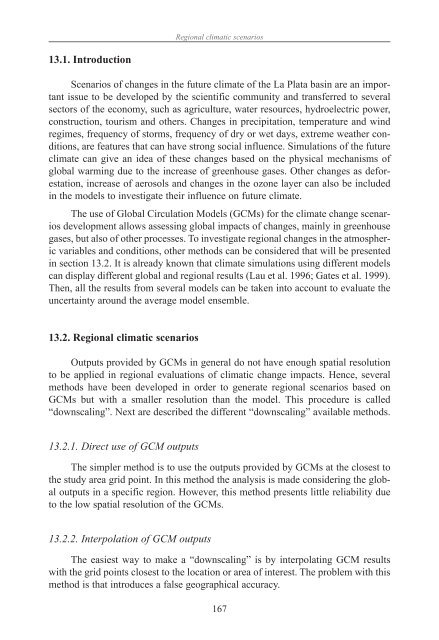chapter - Atmospheric and Oceanic Science
chapter - Atmospheric and Oceanic Science
chapter - Atmospheric and Oceanic Science
Create successful ePaper yourself
Turn your PDF publications into a flip-book with our unique Google optimized e-Paper software.
13.1. Introduction<br />
Scenarios of changes in the future climate of the La Plata basin are an important<br />
issue to be developed by the scientific community <strong>and</strong> transferred to several<br />
sectors of the economy, such as agriculture, water resources, hydroelectric power,<br />
construction, tourism <strong>and</strong> others. Changes in precipitation, temperature <strong>and</strong> wind<br />
regimes, frequency of storms, frequency of dry or wet days, extreme weather conditions,<br />
are features that can have strong social influence. Simulations of the future<br />
climate can give an idea of these changes based on the physical mechanisms of<br />
global warming due to the increase of greenhouse gases. Other changes as deforestation,<br />
increase of aerosols <strong>and</strong> changes in the ozone layer can also be included<br />
in the models to investigate their influence on future climate.<br />
The use of Global Circulation Models (GCMs) for the climate change scenarios<br />
development allows assessing global impacts of changes, mainly in greenhouse<br />
gases, but also of other processes. To investigate regional changes in the atmospheric<br />
variables <strong>and</strong> conditions, other methods can be considered that will be presented<br />
in section 13.2. It is already known that climate simulations using different models<br />
can display different global <strong>and</strong> regional results (Lau et al. 1996; Gates et al. 1999).<br />
Then, all the results from several models can be taken into account to evaluate the<br />
uncertainty around the average model ensemble.<br />
13.2. Regional climatic scenarios<br />
Outputs provided by GCMs in general do not have enough spatial resolution<br />
to be applied in regional evaluations of climatic change impacts. Hence, several<br />
methods have been developed in order to generate regional scenarios based on<br />
GCMs but with a smaller resolution than the model. This procedure is called<br />
“downscaling”. Next are described the different “downscaling” available methods.<br />
13.2.1. Direct use of GCM outputs<br />
The simpler method is to use the outputs provided by GCMs at the closest to<br />
the study area grid point. In this method the analysis is made considering the global<br />
outputs in a specific region. However, this method presents little reliability due<br />
to the low spatial resolution of the GCMs.<br />
13.2.2. Interpolation of GCM outputs<br />
Regional climatic scenarios<br />
The easiest way to make a “downscaling” is by interpolating GCM results<br />
with the grid points closest to the location or area of interest. The problem with this<br />
method is that introduces a false geographical accuracy.<br />
167






